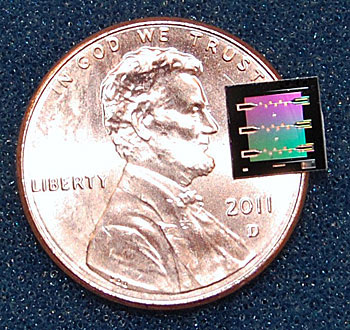 Showcasing new tools for widespread development of quantum circuits made of mechanical parts, scientists from the National Institute of Standards and Technology (NIST) have demonstrated a flexible, broadly usable technique for steadily calming the vibrations of an engineered mechanical object down to the quantum 'ground state', the lowest possible energy level.
Showcasing new tools for widespread development of quantum circuits made of mechanical parts, scientists from the National Institute of Standards and Technology (NIST) have demonstrated a flexible, broadly usable technique for steadily calming the vibrations of an engineered mechanical object down to the quantum 'ground state', the lowest possible energy level.
Jul 6th, 2011
Read more
An automatic and portable detector that takes just fifteen minutes to analyze a sample suspected of contamination with anthrax is being developed by US researchers. The technology amplifies any anthrax DNA present in the sample and can reveal the presence of just 40 microscopic cells of the deadly bacteria Bacillus anthracis.
Jul 6th, 2011
Read more
Researchers at the Georgia Institute of Technology have designed a multiple-compartment gel capsule that could be used to simultaneously deliver drugs of different types. The researchers used a simple "one-pot" method to prepare the hydrogel capsules, which measure less than one micron.
Jul 6th, 2011
Read more
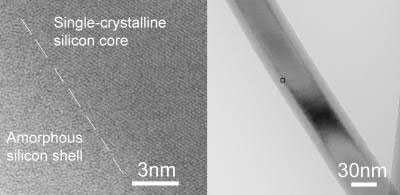 Development holds promise for photodetectors and energy harvesting applications like solar cells.
Development holds promise for photodetectors and energy harvesting applications like solar cells.
Jul 6th, 2011
Read more
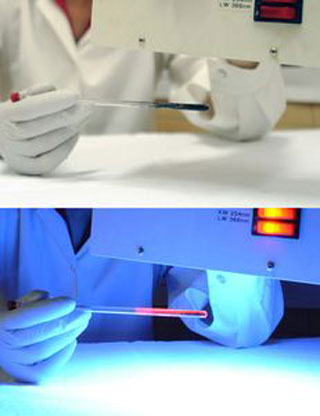 To the human eye, carbon nanotubes usually appear as a black powder. They can hardly be forced to emit light, as they are excellent electrical conductors and capture the energy from other luminescent chemical species placed nearby. The researchers from the Institute of Physical Chemistry of the Polish Academy of Sciences in Warsaw contributed recently to the development of a relatively simple method allowing the nanotubes exposed to UV to emit red light.
To the human eye, carbon nanotubes usually appear as a black powder. They can hardly be forced to emit light, as they are excellent electrical conductors and capture the energy from other luminescent chemical species placed nearby. The researchers from the Institute of Physical Chemistry of the Polish Academy of Sciences in Warsaw contributed recently to the development of a relatively simple method allowing the nanotubes exposed to UV to emit red light.
Jul 6th, 2011
Read more
Freeze-dried gene therapy system avoids virus, potential complications.
Jul 6th, 2011
Read more
Many cell types in higher organisms are capable of implementing directed motion in response to the presence of certain chemical attractants in their vicinity. A team at the Center for NanoScience (CeNS) at Ludwig-Maximilians-Universitaet (LMU) Muenchen has developed a novel technique to expose an ensemble of living cells to rapidly varying concentrations of chemoattractants.
Jul 6th, 2011
Read more
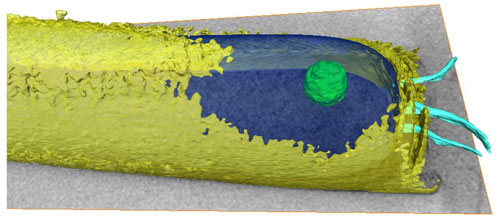 Energy-storage capacity of ancient microorganism could lead to power source for synthetic cells.
Energy-storage capacity of ancient microorganism could lead to power source for synthetic cells.
Jul 6th, 2011
Read more
The U.S. Environmental Protection Agency (EPA), as part of its Science to Achieve Results (STAR) program, is seeking applications proposing to conduct research necessary to identify, develop and demonstrate novel and innovative treatment technologies and approaches for small public drinking water systems.
Jul 6th, 2011
Read more
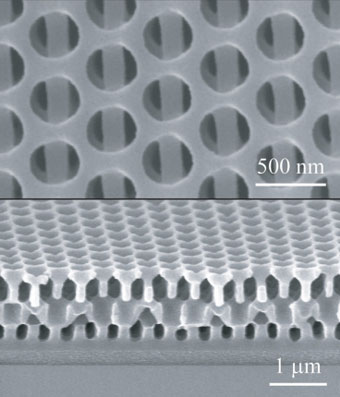 The making of three-dimensional nanostructured materials - ones that have distinctive shapes and structures at scales of a few billionths of a meter - has become a fertile area of research, producing materials that are useful for electronics, photonics, phononics and biomedical devices. But the methods of making such materials have been limited in the 3-D complexity they can produce. Now, an MIT team has found a way to produce more complicated structures by using a blend of current "top-down" and "bottom-up" approaches.
The making of three-dimensional nanostructured materials - ones that have distinctive shapes and structures at scales of a few billionths of a meter - has become a fertile area of research, producing materials that are useful for electronics, photonics, phononics and biomedical devices. But the methods of making such materials have been limited in the 3-D complexity they can produce. Now, an MIT team has found a way to produce more complicated structures by using a blend of current "top-down" and "bottom-up" approaches.
Jul 6th, 2011
Read more
 Prof. Dr. Dr. h. c. Stefan Hell of the Max Planck Institute for Biophysical Chemistry in Goettingen is to receive the 2011 Koerber European Science Prize endowed with 750,000 euros for his pioneering discoveries in the field of optics.
Prof. Dr. Dr. h. c. Stefan Hell of the Max Planck Institute for Biophysical Chemistry in Goettingen is to receive the 2011 Koerber European Science Prize endowed with 750,000 euros for his pioneering discoveries in the field of optics.
Jul 6th, 2011
Read more
A University of Southampton nanoscientist is working on a new microsystem for more efficient testing of pharmaceutical drugs to treat diseases such as cystic fibrosis, MG (myasthenia gravis) and epilepsy.
Jul 6th, 2011
Read more
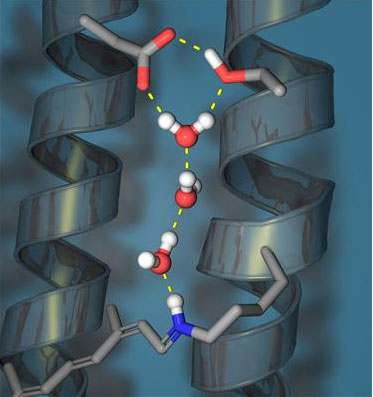 Researchers from the Ruhr-Universitaet-Bochum (RUB) Department of Biophysics of Prof. Dr. Klaus Gerwert have succeeded in providing evidence that a protein is capable of creating a water molecule chain for a few milliseconds for the directed proton transfer. The combination of vibrational spectroscopy and biomolecular simulations enabled the elucidation of the proton pump mechanism of a cell-membrane protein in atomic detail. The researchers demonstrated that protein-bound water molecules play a decisive role in the function.
Researchers from the Ruhr-Universitaet-Bochum (RUB) Department of Biophysics of Prof. Dr. Klaus Gerwert have succeeded in providing evidence that a protein is capable of creating a water molecule chain for a few milliseconds for the directed proton transfer. The combination of vibrational spectroscopy and biomolecular simulations enabled the elucidation of the proton pump mechanism of a cell-membrane protein in atomic detail. The researchers demonstrated that protein-bound water molecules play a decisive role in the function.
Jul 6th, 2011
Read more
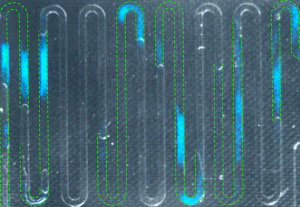 The intense energy released by collapsing bubbles in a microfluidic chip could help speed up chemical reactions.
The intense energy released by collapsing bubbles in a microfluidic chip could help speed up chemical reactions.
Jul 6th, 2011
Read more
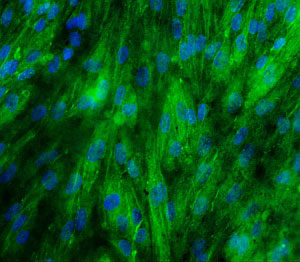 A research team led by Daniele Zink and Jackie Y. Ying at the A*STAR Institute of Bioengineering and Nanotechnology has now developed membrane materials and coatings that are suitable for human proximal tubule cells growth and differentiation by modifying the surface of established materials and synthesizing novel materials.
A research team led by Daniele Zink and Jackie Y. Ying at the A*STAR Institute of Bioengineering and Nanotechnology has now developed membrane materials and coatings that are suitable for human proximal tubule cells growth and differentiation by modifying the surface of established materials and synthesizing novel materials.
Jul 6th, 2011
Read more
 Researchers characterize biomechanics of ovarian cells in mice according to their phenotype at early, intermediate, and late-aggressive stages of cancer.
Researchers characterize biomechanics of ovarian cells in mice according to their phenotype at early, intermediate, and late-aggressive stages of cancer.
Jul 5th, 2011
Read more
 Showcasing new tools for widespread development of quantum circuits made of mechanical parts, scientists from the National Institute of Standards and Technology (NIST) have demonstrated a flexible, broadly usable technique for steadily calming the vibrations of an engineered mechanical object down to the quantum 'ground state', the lowest possible energy level.
Showcasing new tools for widespread development of quantum circuits made of mechanical parts, scientists from the National Institute of Standards and Technology (NIST) have demonstrated a flexible, broadly usable technique for steadily calming the vibrations of an engineered mechanical object down to the quantum 'ground state', the lowest possible energy level. 









 Subscribe to our Nanotechnology News feed
Subscribe to our Nanotechnology News feed